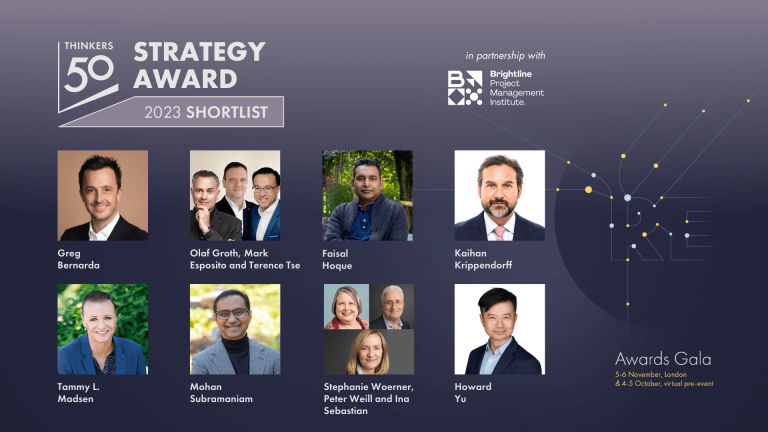

 “By the 1990s strategy had become discredited,” recalls Gary Hamel. “All too often ‘vision’ was ego masquerading as foresight; planning was formulaic, incrementalist and largely a waste of time in a world of discontinuous change; ‘strategic’ investments were those that lost millions, if not billions of dollars. As strategy professors, CK Prahalad and I had a simple choice: change jobs or try to reinvent strategy for a new age. We chose the latter course.”
“By the 1990s strategy had become discredited,” recalls Gary Hamel. “All too often ‘vision’ was ego masquerading as foresight; planning was formulaic, incrementalist and largely a waste of time in a world of discontinuous change; ‘strategic’ investments were those that lost millions, if not billions of dollars. As strategy professors, CK Prahalad and I had a simple choice: change jobs or try to reinvent strategy for a new age. We chose the latter course.”
In their groundbreaking 1994 book, Competing for the Future, Hamel and Prahalad argue that strategy is multi-faceted, emotional as well as analytical, concerned with meaning, purpose and passion. While strategy is a process of learning and discovery, it is not looked on as a learning process and this represents a huge blind spot.
Broader perspectives are necessitated by the ‘emerging competitive reality’ in which the onus is on transforming not just individual organizations but entire industries. The boldness of such objectives is put in perspective when Hamel and Prahalad observe that, for all the research and books on the subject, there remains no theory of strategy creation. Strategy emerges and the real problem, executives perceive, is not creating strategy but in implementing it.
‘We have an enormous appetite for simplicity. We like to believe we can break strategy down to Five Forces or Seven Ss. But you can’t. Strategy is extraordinarily emotional and demanding. It is not a ritual or a once-a-year exercise, though that is what it has become. We have set the bar too low,’ say Hamel and Prahalad. As a result, managers are bogged down in the nitty-gritty of the present – spending less than three percent of their time looking to the future.
Instead of talking about strategy or planning, they advocate that companies should talk of strategizing and ask ‘What are the fundamental preconditions for developing complex, variegated, robust strategies?’ Strategizing is part of the new managerial argot of ‘strategic intent’, ‘strategic architecture’, ‘foresight’ (rather than vision) and, crucially, the idea of ‘core competencies’.
Hamel and Prahalad define core competencies as “the collective learning in the organization, especially how to co-ordinate diverse production skills and integrate multiple streams of technologies” and call on organizations to see themselves as a portfolio of core competencies as opposed to business units. The former are geared to growing ‘opportunity share’ wherever that may be; the latter narrowly focused on market share and more of the same.
In some ways, Hamel and Prahalad’s strategic prognosis falls between two extremes. At one extreme are the arch-rationalists, insisting on a constant stream of data to support any strategy; at the other are the ‘thriving on chaos’ school with their belief in free-wheeling organizations where strategy is a moveable feast.
There is a thin dividing line between order and chaos. ‘Neither Stalinist bureaucracy nor Silicon Valley provide an optimal economic system,’ they caution. ‘Silicon Valley is extraordinarily good at creating new ideas but in other ways is extraordinarily inefficient. There are 100 failures for every success and, in fact, you find that smaller companies usually succeed in partnership with large organizations.’
They conclude that small entrepreneurial off-shoots are not the route to organizational regeneration. They are too random, inefficient and prone to becoming becalmed by corporate indifference. This does not mean that interlopers can’t change the shape of entire industries.
Hamel and Prahalad were also long-standing critics of the corporate obsession with downsizing, labeling it “corporate anorexia”. The golden rules are summed up by Hamel and Prahalad: ‘A company surrenders today’s businesses when it gets smaller faster than it gets better. A company surrenders tomorrow’s businesses when it gets better without getting different.’ Downsizing is an easy option – ‘There is nothing more short-term than a sixty year old CEO holding a fist full of share options’.
Growth (they prefer to talk of vitality) comes from difference; though they add the caveat that “there are as many stupid ways to grow as there are to downsize. You might merge with another organization but two drunks don’t make a sensible person”. The catch-22 for organizations is that vitality is usually ignited by a crisis – something borne out by the burgeoning literature on spectacular turnarounds.
Perhaps reassuringly, Hamel and Prahalad believe vitality comes from within. If only executives would listen – “Go to any company and ask when was the last time someone in their twenties spent time with the board teaching them something they didn’t know. For many it is inconceivable, yet companies will pay millions of dollars for the opinions of McKinsey’s bright 29-year old. What about their own 29-year olds?”
While such questions remain largely unanswered, Hamel and Prahalad are moving on to pose yet more: ‘Something new needed to be said about the content of strategy. Now we need to rethink the process of strategy.’
Hamel’s sequel Leading the Revolution, calls for companies to throw aside their single-strategy business plans and instead develop a deeply embedded capability for continual, radical innovation. Hamel now talks of “creative strategizing”. By way of explanation he says: “First, strategic planning is not strategy. Planning and strategic formulations are very different things. Strategy is discovering and inventing, which makes strategy subversive, and the strategist a rule-breaker, or revolutionary. Second, the real barrier to strategic planning is generally at the top, not in the middle nor at the bottom. The objective of the revolutionary is to free the process from the tyranny of the past. Its guardians are at the top. And, third, you cannot expect to see the end at the start. The strategic formulation is a discovery process and a moment of invention. It is not selling to those in the middle and at the bottom something already defined by those at the top or from outsiders (the external consultants).”
For CK Prahalad the entire notion of core competencies was driven by his belief in the necessity of democratizing commerce. This is how he explained it to us: “Think about core competences as an idea. Core competence is not about top management; it’s about ordinary workers, ordinary people, the ordinary technical community and the worker community working together to create intellectual capital. We are basically saying that intellectual capital is critical for companies to succeed, so don’t underestimate the value added and the criticality of ordinary people. It’s not all the top guys.”
Resources
Gary Hamel and CK Prahalad, Competing for the Future, Harvard Business School Press, 1994.
This was originally published in What we mean when we talk about strategy by Stuart Crainer and Des Dearlove (Infinite Ideas, 2016).

Thinkers50 Limited
The Studio
Highfield Lane
Wargrave RG10 8PZ
United Kingdom

Thinkers50 Limited
The Studio
Highfield Lane
Wargrave RG10 8PZ
United Kingdom

| Cookie | Duration | Description |
|---|---|---|
| LANG | 9 hours | Linkedin set this cookie to set user's preferred language. |
| nsid | session | This cookie is set by the provider PayPal to enable the PayPal payment service in the website. |
| sp_landing | 1 day | The sp_landing is set by Spotify to implement audio content from Spotify on the website and also registers information on user interaction related to the audio content. |
| sp_t | 1 year | The sp_t cookie is set by Spotify to implement audio content from Spotify on the website and also registers information on user interaction related to the audio content. |
| tsrce | 3 days | PayPal sets this cookie to enable the PayPal payment service in the website. |
| x-pp-s | session | PayPal sets this cookie to process payments on the site. |
| __cf_bm | 30 minutes | This cookie, set by Cloudflare, is used to support Cloudflare Bot Management. |
| Cookie | Duration | Description |
|---|---|---|
| l7_az | 30 minutes | This cookie is necessary for the PayPal login-function on the website. |
| Cookie | Duration | Description |
|---|---|---|
| CONSENT | 2 years | YouTube sets this cookie via embedded youtube-videos and registers anonymous statistical data. |
| _ga | 2 years | The _ga cookie, installed by Google Analytics, calculates visitor, session and campaign data and also keeps track of site usage for the site's analytics report. The cookie stores information anonymously and assigns a randomly generated number to recognize unique visitors. |
| _gat_gtag_UA_10408481_1 | 1 minute | Set by Google to distinguish users. |
| _ga_ZP8HQ8RZXS | 2 years | This cookie is installed by Google Analytics. |
| _gid | 1 day | Installed by Google Analytics, _gid cookie stores information on how visitors use a website, while also creating an analytics report of the website's performance. Some of the data that are collected include the number of visitors, their source, and the pages they visit anonymously. |
| Cookie | Duration | Description |
|---|---|---|
| NID | 6 months | NID cookie, set by Google, is used for advertising purposes; to limit the number of times the user sees an ad, to mute unwanted ads, and to measure the effectiveness of ads. |
| test_cookie | 15 minutes | The test_cookie is set by doubleclick.net and is used to determine if the user's browser supports cookies. |
| VISITOR_INFO1_LIVE | 5 months 27 days | A cookie set by YouTube to measure bandwidth that determines whether the user gets the new or old player interface. |
| YSC | session | YSC cookie is set by Youtube and is used to track the views of embedded videos on Youtube pages. |
| yt-remote-connected-devices | never | YouTube sets this cookie to store the video preferences of the user using embedded YouTube video. |
| yt-remote-device-id | never | YouTube sets this cookie to store the video preferences of the user using embedded YouTube video. |
| yt.innertube::nextId | never | This cookie, set by YouTube, registers a unique ID to store data on what videos from YouTube the user has seen. |
| yt.innertube::requests | never | This cookie, set by YouTube, registers a unique ID to store data on what videos from YouTube the user has seen. |
| Cookie | Duration | Description |
|---|---|---|
| DEVICE_INFO | 5 months 27 days | No description |
| loglevel | never | No description available. |
| m | 2 years | No description available. |
Thinkers50 Limited has updated its Privacy Policy on 28 March 2024 with several amendments and additions to the previous version, to fully incorporate to the text information required by current applicable date protection regulation. Processing of the personal data of Thinkers50’s customers, potential customers and other stakeholders has not been changed essentially, but the texts have been clarified and amended to give more detailed information of the processing activities.